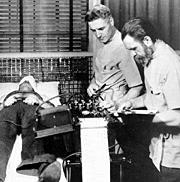BJ's $50,000 Timpograph
|
Still captures the imagination after more than fifty years...
|
 One day last spring, while poking around a back closet in the Tom and Mae Bahan Library of Sherman College, I found myself face-to-face with B.J. Palmer's second electroencephaloneuromentimpograh. I had read about it in the Green Books. I had discussed it with students and chiropractors. Suddenly, I was touching it. This was one of two machines B.J. Palmer designed and had built at a reported cost of over $50,000.00. And that was over fifty years ago! (The first machine ran on batteries, this one uses 115V/60 cycles.) The timpograph was an improvement of the Keeler polygraph machine and a predecessor to today's electroencephalograph and electrocardiograph instruments. (The local police used to bring murder suspects to Dr. Palmer's Clinic for "evaluation.") My grandfather was a master carpenter, and my father owned the village hardware store in New Era, Michigan, so I grew up loving tools. I love chiropractic, and I love B.J. I had to plug it in. I had to see it work on a patient! I made an appointment with the College's President, Thom Gelardi. "Yes, we bought it over ten years ago from the Maharishi Institute for three hundred dollars. A former student, Katherine Mermin, told me about it. Anyway, it doesn't work." "I can fix it," I replied. I discovered it was missing a fuse. The closest one I could find was made for the cigarette lighter of a 1951 Ford. I turned it on, and the sweet smell of ozone filled the air as the needles started burning lines onto the metal backed paper! With the investment of a dollar and a quarter, we were back in business. I moved it to the maintenance building, stripped off several layers of green and yellow paint, polished the corroded stainless steel; removed, cleaned and reassembled the eight boards and sixty five vacuum tubes. We purchased some new leads, hooked one pair up to chiropractic student Keith Lynch's occiput, and another pair on his spine, and made our first graph. It took about fifteen minutes to learn how to pronounce e-lec-tro-en-ceph-a-lo-neu-ro-men-timp-o-graph. I thought it had something to do with measuring heat, by the "timp," but it doesn't. B.J. considered heat to be a by-product of a subluxation. It means electro- (electrical), encephalo- (brain), neuro- (nerve), ment- (mental), imp- (impulse), graph- (record). "At bottom, all chemical action is electrical," stated B.J. He felt this instrument could prove the existence and location of a subluxation, and the validity of the adjustment that restored full neuro/electrical transmission past the subluxation. B.J. wanted to locate THE subluxation, because he would only adjust one place, with a gross average of 28.9 days between adjustments. It is fundamental to see HOW LITTLE we can do, at HOW FEW PLACES, HOW RARELY, and HOW QUICKLY it can be done, to accomplish the greatest change in the SHORTEST SPACE OF TIME, AT LEAST COST to case, and to know WHAT to do and WHY we do it, BEFORE doing it. Timpographs pick up subluxations direct. "This does not coincide with the teachings of Sherman College or its founder, Dr. Gelardi, "Subluxation involves a metaphysical component. It is more than a biological phenomenon. You can measure the altered expression that results from a subluxation, you can know most components of a subluxation, but never know the complete subluxation directly. The school is named in honor of Lyle W. Sherman, one time assistant director of the B.J. Palmer Chiropractic Research Clinic in Davenport, Iowa. Dr. Sherman moved away from the "break" system, where hot places along the spine, detected either with the back of the fingers or with the neurocalograph, were thought to indicate subluxated vertebrae. His research showed that many "hot boxes" were transitory and not of chiropractic significance, and even the constant "hot boxes" do not point to the site of the subluxation. Dr. Sherman pioneered the development of pattern work, which graphs consistent, persistent heat patterns unique to an individual's spine. The return of those patterns when subluxation returns demonstrates a propensity for vertebrae to misalign in the same way during each appearance of subluxation. What role will chiropractic instrumentation play fifty years from now, in 2045? I suppose you will go to Wal-Mart, back your spine up to a special plate, stick your credit card in an adjusting machine, and an Activator will correct your subluxation. Maybe, but, call me old fashioned, I still believe a caring person's hands, using rational intuitive knowledge, will be making decisions and performing adjustments. |
 Back
Back
|

